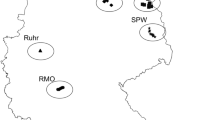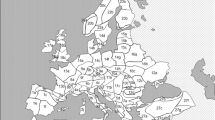Abstract
Our first aim was to document the effects of palaeotemperatures and vegetation changes on beetle assemblages, and secondly to determine the extent to which surrogacy analysis at the family taxonomic level reveals patterns evident from lower taxa analysis. The sedimentary sequence sampled on the experimental site of ‘La Grande Pile’ (Vosges, France) covers the whole of the last climatic cycle. Beetle fragments were extracted from 39 coring samples and identified to the lowest possible taxonomic level. A total of 3092 beetle specimens belonging to 394 taxa were identified, more than half to species level. Carabidae, Staphylinidae and Curculionidae families together represented 40% of the overall taxa richness. Beetle taxa richness and assemblage composition varied markedly over time. Average summer temperatures clearly play a major role in diversity patterns, as temperature was positively correlated with taxon richness. Nevertheless, the warmest and the coldest periods were not the richest and the poorest, respectively, and the most humid period did not correspond to maximum beetle richness. Beetle assemblages are likely to fluctuate in response to other factors such as plant diversity and vegetation structure. Steppe-like vegetation did not reduce species richness while dense, homogenous and closed forests did. Family patterns mirrored those observed at the lower taxa level. This makes the family level a convincing alternative to lower taxonomic level analyses by representing a faithful picture of changing beetle diversity over a long period of time. Finally, evolution of beetle diversity over the Quaternary represents a convincing model for evaluating the effect of close and wide past climate changes, and for assisting in management of present-day biodiversity as part of the current anthropogenic global climate change.
Similar content being viewed by others
References
Atkinson T.C., Briffa K.R., Coope G.R., Joachim M.J. and Perry D.W. 1986. Climatic calibration of coleopteran data. In: Berglund B.E. (ed.), Handbook of Holocene Palaeoecology and Palaeohydrology. Wiley, Chichester, UK, pp. 851–858.
Barbault R. 1995. Écologie générale, Structure et fonctionnement de la biosphere. Masson, Paris.
de Beaulieu J.L. and Reille M. 1992. The last climatic cycle at La Grande Pile (Vosges, France): a new pollen profile. Quaternary Science Review 11: 431–438.
Bell M.A. 2000. Bridging the gap between population biology and paleobiology. Evolution 54: 1457–1461.
Bell M. and Walker M.J.C. 1992. Late Quaternary Environmental Change: Physical and Human Perspectives. Longman, London.
Bennett K.D. 1990. Milankovitch cycles and their effects on species in ecological and evolutionary time. Paleobiology 16: 11–21.
Birks H.J.B. and Birks H.H. 1980. Quaternary Palaeoecology. Edward Arnold, London.
Buckland P.C. and Coope G.R. 1991. A Bibliography and Literature Review of Quaternary Entomology. JR Collis Publications, University of Sheffield, Sheffield, UK.
Cheddadi R., Mamakova K., Guiot J., de Beaulieu J.L., Reille M., Andrieu V. et al. 1998. Was the climate of the Eemian stable? A quantitative climate reconstruction from seven European pollen records. Palaeogeography, Palaeoclimatology, Palaeoecology 143: 73–85.
Chessel D. 1995. ADE-4, Ordination sous contrainte. Institut d'analyse des Systèmes Biologiques et Socio-économiques, Université de Lyon 1, Lyon, France.
Cong S. and Ashworth A.C. 1997. The use of correspondence analysis in the analysis of fossil beetle assemblages. In: Ashworth A.C., Buckland P.C. and Sadler J.P. (eds), Studies in Quaternary Entomology ¶ An Inordinate Fondness for Insects. Quaternary Proceedings No. 5. Wiley, Chichester, UK, pp. 79–82.
Coope G.R. 1975. Climatic fluctuations in northwest Europe since the last Interglacial, indicated by fossil assemblages of Coleoptera. In: Wright A.E. and Moseley F. (eds), Ice Ages: Ancient and Modern. Seel House Press, Liverpool Geological Journal Special Issue 6, pp. 153–168.
Coope G.R. 1978. Constancy of insect species versus inconstancy of Quaternary environments. In: Mound L.A. and Waloff N. (eds), Diversity of Insect Faunas (Symposia of the Royal Entomological Society of London 9). Blackwell, Oxford, UK, pp. 176–187.
Coope G.R. 1986. Coleoptera analysis. In: Berglund B.E. (ed.), Handbook of Holocene Palaeoecology and Palaeohydrology. Wiley, Chichester, UK, pp. 703–713.
Coope G.R. 1990. The invasion of Northern Europe during the Pleistocene by Mediterranean species of Coleoptera. In: di Castri F., Hansen A.J. and Debussche M. (eds), Biological Invasions in Europe and the Mediterranean Basin. Kluwer, Dordrecht, The Netherlands, pp. 203–215.
Coope G.R. 1991. The study of the ‘nearly fossil’. Antenna 15: 158–163.
Coope G.R. 1994. The response of insect faunas to glacial¶interglacial climatic fluctuations. Philosophical Transactions of the Royal Society of London B 344: 19–26.
Coope G.R. and Elias S.A. 2000. The environment of Upper Palaeolithic (Magdalenian and Azilian) hunters at Hauterive-Champréveyres, Neuchâtel, Switzerland, interpreted from Coleopteran remains. Journal of Quaternary Science 15: 157–175.
Coope G.R., Shotton F.W. and Strachan I. 1961. A Late Pleistocene fauna and flora from UptonWarren, Worcestershire. Philosophical Transactions of the Royal Society of London B 244: 379–421.
Elias S.A. 1994. Quaternary Insects and Their Environments. Smithsonian Institution Press, Washington, DC.
Eyre M.D., Lott D.A. and Luff M.L. 2001. The rove beetles (Coleoptera, Staphylinidae) of exposed riverine sediments in Scotland and northern England: habitat classification and conservation aspects. Journal of Insect Conservation 5: 173–186.
Fatuyama D.J. 1987. On the role of species in anagenesis. The American Naturalist 130: 465–473.
Kenward H. 1975. Pitfalls in the environmental interpretation of insect death assemblages. Journal of Archaeological Science 2: 85–94.
Kenward H. 1976. Reconstructing ancient ecological conditions from insect remains: some problems and an experimental approach. Ecological Entomology 1: 7–17.
Lowe J.J. and Walker M.J.C. 1997. Reconstructing Quaternary Environments. Longman, London.
Magagula C.N. and Samways M.J. 2001. Maintenance of ladybeetle diversity across a heterogenous African agricultural /savanna land mosaic. Biodiversity and Conservation 10: 209–222.
Ponel P. 1994. Les fluctuations climatiques au Pléniglaciaire würmien déduites des assemblages d'Arthropodes fossiles à La Grande Pile (Haute-Saône, France). Compte-Rendus de l'Académie des Sciences, Paris 319: 845–852.
Ponel P. 1995a. Rissian, Eemian and Würmian Coleoptera assemblages from La Grande Pile (Vosges, France). Palaeogeography Palaeoclimatology Palaeoecology 114: 1–41.
Ponel P. 1995b. Aspects de la biodiversité entomologique des contreforts préalpins et des Plans de Canjuers (Var) [Coleoptera]. Faune de Provence 16: 39–50.
Ponel P. and Richoux P. 1997. Difficultés d'interprétation des assemblages de Coléopteres fossiles quaternaires en milieu d'altitude. Geobios MS 21: 213–219.
Pons A., Guiot J., de Beaulieu J.L. and Reille M. 1992. Recent contribution to the climatology of the last glacial¶interglacial cycle based on French pollen sequences. Quaternary Sciences Review 11: 439–448.
Reille M. 1990. Leçons de palynologie et d'analyse pollinique. CNRS ed., Paris.
Rioual P., Andrieu-Ponel V., Battarbee R.W., de Beaulieu J.L., Cheddadi R., Reille M. et al. 2001. High-resolution record of climate stability in France during the last Interglacial. Nature 413: 293–296.
Rosenzweig M.L. 1995. Species Diversity in Space and Time. Cambridge University Press, Cambridge, UK.
Samways M.J., Osborn R., Hastings H. and Hattingh V. 1999. Global climatic change and accuracy of prediction of species' geographical ranges: establishment success of introduced ladybirds (Coccinellidae, Chilocorus spp.) worldwide. Journal of Biogeography 26: 795–812.
Walkling A.P. and Coope G.R. 1996. Climatic reconstructions from the Eemian/ Early Weichselian transition in Central Europe based on the coleopteran record from Gröbern, Germany. Boreas 25: 145–159.
Wilson M.V.H. 1988. Taphonomic processes: information loss and information gain. Geoscience Canada 15: 131–148.
Woillard G. 1975. Recherches palynologiques sur le Pléistocène dans l'Est de la Belgique et desVosges lorraines. Travaux du Laboratoire de Palynologie et Phytosociologie, Université Catholique de Louvain.
Woillard G. 1978. Grande Pile peat bog: a continuous pollen record for the last 140000 years. Quaternary Research 9: 1–21.
Woillard G. and Moock W. 1982. Carbon dates at Grande Pile: correlation of land and sea chronologies. Science 215: 159–161.
Rights and permissions
About this article
Cite this article
Ponel, P., Orgeas, J., Samways, M. et al. 110000 years of Quaternary beetle diversity change. Biodiversity and Conservation 12, 2077–2089 (2003). https://doi.org/10.1023/A:1024121327109
Issue Date:
DOI: https://doi.org/10.1023/A:1024121327109




